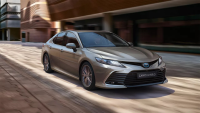The 1997 Toyota Camry passenger car was equipped with the bodywork of the then new generation XV20. The car was actively marketed in Australia, Oceania and North America, but is hardly ever seen in EU. Simultaneously, Japanese buyers offered generation V40 Vista, differing by body size and engine list. Vehicles with used vehicles in large quantities were imported to EU through customs terminals in Vladivostok and ports on Sakhalin island.
Toyota Camry 1997 can be called one of the best cars.
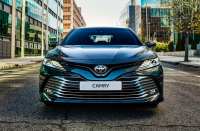
A brief description of the 1997 Toyota Camry
The cars were equipped with a 4-door sedan body designed to carry 5 passengers. The XV20 was available in Europe and North America with front-wheel drive, and the G-Four with a four-wheel drive system with viscous clutch was available for Japanese customers.
The Vista variant was available with sedan or hardtop bodies (sold only through Toyota Vista Store). It differed from the XV20 by having a body in a smaller size than the XV20, which was tax deductible under Japanese legislation.
Features and specifications
The V40 had McPherson strut front suspension with anti-roll bar, and rubber wishbone rear hubs. The brakes were hydraulic, with ventilated discs with floating brackets at the front and drums (with automatic clearance adjustment) or discs in the rear. Power steering was rack and pinion type, for an extra fee the factory offered 4WS (4 Wheel Steering) to improve maneuverability.
Read also: 2013 Toyota Venza (Toyota Venza) video review and test drive
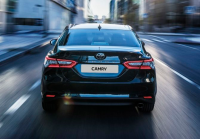
The base model had electric side windows and instrument cluster with arrow indicators. Improved models used Optitron combination with improved illumination of the scales. The steering wheel was made of polyurethane, and there were cars with a rim with wooden inserts on top and bottom. Some trucks had an electrically operated glass sunroof. Radio and CD player or navigation system with colour touch screen display were installed.
Specification
The 1997 Toyota Camry was equipped with stabilizer bar front suspension.
The ventilation and heating system had separate air ducts that delivered airflow to passengers in the rear row of seats. An air ioniser located in the air deflector in front of the driver's seat was used. The manufacturer offered electrically adjustable front seats with memory position.
The door trim depended on the material used for the seat upholstery, and there were bottle pockets in the front overlays.
Technical parameters of the car generation V40 (front-wheel drive model with 2.2L engine, 1997 model year):
curb weight - 1450 kg;
allowable full weight - 1725 kg;
average fuel consumption (by Japanese standard) - 10.2 km per 1 liter of fuel
body length - 4800 mm
width - 1785 mm
height - 1420 mm
wheelbase - 2670 mm;
ground clearance - 145 mm.
What difficulties modern owners will face
No matter how good and reliable the car is, time will take its toll. Today, looking at the photos, these cars already seem old-fashioned, with relatively square and rectilinear forms. Aesthetics are the exterior and the first downside of the car now. The car lacks many of the electronic auxiliary features that modern instances are equipped with.
When buying a trimmed 2000 Toyota Camry, for instance, the new owner will be faced with the need to replace virtually the entire suspension. One should pay attention to water pump, which tends to loosen after 2-3 years of exploitation in these versions.
Japanese producers have not in vain given a six-year warranty for metal corrosion, because till that moment the body really preserved its luster. However, 15-year-old cars may already start having rust problems.
Advantages and disadvantages
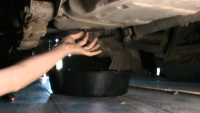
Advantages of the car, noted by the owners:
long life of the engine piston group (some instances have passed more than 600 thousand km without overhaul);
high quality of plastic and coating on decorative inserts;
roomy luggage compartment with the possibility to increase the capacity by partial or full folding of the back sofa;
wishbone suspension does not transmit vibrations and shocks when driving on rough roads;
availability of cheap spare parts from alternative suppliers (parts of inferior quality to original products).
Advantages
The car is of high quality and the availability of cheap spare parts.
The disadvantages indicated in the reviews and reviews are:
long engine piston group life (some models have gone over 600,000 km without overhaul);
high quality plastics and coatings on decorative inserts;
spacious luggage compartment with the possibility to increase the capacity by partially or fully folding the rear sofa;
wishbone suspension does not transmit vibrations and shocks when driving on rough roads;
availability of cheap spare parts from alternative suppliers (parts of inferior quality to original products).
Advantages
The car is of high quality and the availability of cheap spare parts.
The disadvantages indicated in the reviews and reviews are:
The age of the car, negatively affecting the condition of the bodywork;
Increased fuel consumption due to the use of outdated automatic 4-speed transmission;
difficulty in procuring new genuine parts;
large turning radius, making manoeuvring in tight spaces difficult;
cracked windscreens due to localised overheating from a heater (a problem in northern regions)
engine oil leaks at the joints due to natural ageing of seals and gaskets (after overhaul the defect disappears).
Front Independent, sprung, MacPherson type, with anti-roll bar Independent, sprung, MacPherson type, with anti-roll bar Independent, sprung, MacPherson type, with anti-roll bar
Rear Independent, spring-mounted on the longitudinal and transverse arms, MacPherson strut, anti-roll bar Independent, spring-mounted on the longitudinal and transverse arms, MacPherson strut, anti-roll bar Independent, spring-mounted on the longitudinal and transverse arms, MacPherson strut, anti-roll bar
Engines 2.4-liter VVT-i 5 MKP 2.4-liter VVT-i 5 automatic transmission 3.5 VVT-i 6 automatic transmission
Front brakes (size, mm) Ventilated discs ( ? 296 x 28 mm) Ventilated discs ( ? 296 x 28 mm)
Rear brakes (mm) Non-vented discs ( ? 281 x 10 mm) Non-vented discs ( ? 281 x 10 mm) Non-vented discs ( ? 281 x 10 mm)
Wheel rims and tyres
Engines 2.4-liter VVT-i 5 MKP 2.4-liter VVT-i 5 ACP 3.5 VVT-i 6 ACP
Tyre size 215/60R16 215/60R16
Wheel rims Light-alloy Light-alloy
Engines 2.4-liter VVT-i 5 MKP 2.4-liter VVT-i 5 automatic transmission 3.5 VVT-i 6 automatic transmission
Type Gear-bracket steering, Power assisted steering Gear-bracket steering, Power assisted steering
Minimum turning radius at outside tyre (m) 5.5 5.5 5.5
engines 2.4-litre VVT-i 5 MKP 2.4-litre VVT-i 5 automatic transmission 3.5 VVT-i 6 automatic transmission
Overall length (mm) 4815 4815
Overall width (mm) 1820 1820 1820
Overall height (mm) 1480 1480 1480
Fuel tank capacity (l) 70 70 70
Wheelbase (mm) 2775 2775 2775
Rear wheel track (mm) 1575 1575 1575
Width of front wheels (mm) 1580 1580 1580
Front overhang (mm) 955 955 955
Rear overhang (mm) 1085 1085
Ground clearance (mm) 160 160 160
Saloon length (mm) 2130 2130 2130
Interior width (mm) 1525 1525 1525
Saloon height (mm) 1200 1200 1200
Curb weight (kg) 1520-1600 1540-1620 1610-1685
Maximum weight (kg) 1985 1985 2050
Cargo area capacity, l 535 504
Development history
The Toyota Camry's fuel system operates on traditional technology. Fuel is supplied to the engine by a fuel pump directly from the fuel tank via a hose system running along the body. This was the case in the first Toyota Camry, and the same system remains in the latest versions.
The volume of the tank in these models was traditionally 70 litres. According to Japanese engineers, it is the most optimum litre in relation to weight, occupied space and distance run. However, for the 1990s, the carmaker decided to experiment a bit, and the cars were fitted with a 60.2-litre tank. This can be seen on the 1990 and 1991 models. But then such a solution has not found a positive response, and the manufacturer returned to the previous standard.
Another variant with a 60-litre tank was launched by the auto giant in 2007. But then this technical characteristic was justified by the fact that the car was equipped with a hybrid engine. By the way, such versions were not assembled in Europe and were not imported from Japan. The same cannot be said about the US and Australian market, where the hybrid versions were in demand and were very popular.
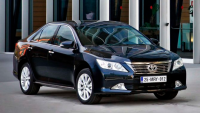
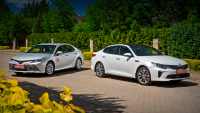
-rear-and-front-view-camera-6.png)
